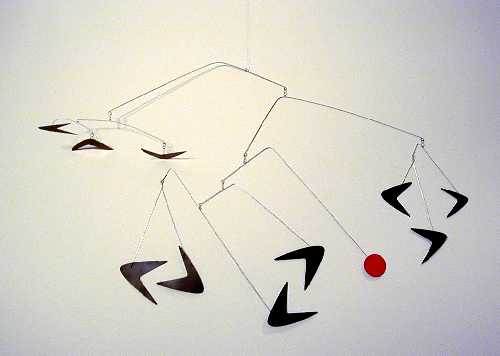I went to Chicago this past weekend to see the special exhibit "
Alexander Calder and Contemporary Art: Form, Balance, Joy". With over 60 sculptures by Calder on display, plus inspired works by seven contemporary artists, this was a "must see" for me and I wasn't disappointed!
There were so many iconic pieces there; "Big Red", "Finny Fish", "Portrait of the Artist", "Flying Fish", "Little Face", "Performing Seal", among so many others - it was simply amazing to see them with my own eyes, inches away from me, and in motion. It was if one of my Calder books had come to life.
I have to give credit to the Chicago Museum of Contemporary Art for putting on such a wonderful show. I especially appreciated the manner in which the mobiles were hung at eye level, which according to the audio tour, was how Calder intended them to be viewed. For me, it was a religious experience to stand face to face with these beautiful sculptures and watch the quiet dignity of their movement, influenced by the air currents created by the wanderings of the museum patrons. It also allowed me to closely inspect the methods that Calder used to construct his mobiles.
I noticed something very important about how Calder worked.
As I moved from piece to piece, I became aware of the differences between Calder's skill and the way I make mobiles. For me, the artistic and creative process primarily lies in the initial concept for a mobile, which I usually develop in a sketch. After that, I switch into "engineer mode" and do my best to create the sculpture as accurately as possible to reflect this idea using the cutting, joining, and painting methods that I have developed over the years. I spend a lot of time making sure that things are "just so" - ensuring that the wires are smoothly bent, connections are uniform, elements are hanging perfectly vertical (or horizontal), and the paint is as nice as it can be. It's time consuming. If necessary, I'll remove and replace a section of the mobile to correct a problem.
Calder, on the other hand, did not let his engineering talents become a hindrance to the creative process at any point. It is clearly obvious that for him, the process of constructing a complex hanging mobile was no different than making a quick pen and ink sketch. There is a free flowing magical quality to the way that he bent the wire, and his willingness to be unencumbered by convention can be seen in a multiplicity of ways; such as by the way he used variations in joining methods from piece to piece (or even within a single piece), how he would sometimes rivet a chunk of metal to a petal to make it heavier when necessary, how he would extend the length of a wire arm by simply splicing another piece onto it with a clever interlocking bend, and how he wasn't afraid to leave a ragged edge here or there.
The spontaneity of the construction method jumps out at you when you see these sculptures up close, and it becomes apparent how it augments the overall impression of an organic spontaneous playfulness of the mobile's movement. I think Calder's genius was the way he was able to put so much
action into his sculptures. I can't think of any other sculptor that has been able to do this so well.
Most people are familiar with the concept of "karma", but many incorrectly have the impression that there is "good karma" and "bad karma" - merit badges in some law of cosmic justice that is basically "what goes around, comes around". In fact, karma simply means "action" and though it powers the cycle of cause and effect it has no good or bad qualities within itself. You also may not know that there is a form of yoga known as "karma yoga". Since yoga means "union", the literal translation of karma yoga is "the path of union through action". In other words, it is not "the ends justify the means", but rather "the means
are the ends". For an artist, this would be practiced by letting go of one's tendency to be attached to the idea of the finished result and instead be at one with each moment of the creative process.
I think Calder's art clearly shows his impressive and perhaps unequaled ability to achieve this kind of unencumbered creativity - a
karmic yoga, in his work - a feat difficult for any artist but especially so I think, for a sculptor. Look closely, and you'll see that every bend, crimp, loop, and petal of a Calder mobile is a unique work of art within itself.
Looking at the beautiful mobiles and stabiles at the MoCA, I couldn't help but think, if you could somehow plant a chunk of steel into the ground and make it grow, it would grow into a Calder.
























.jpg)

















